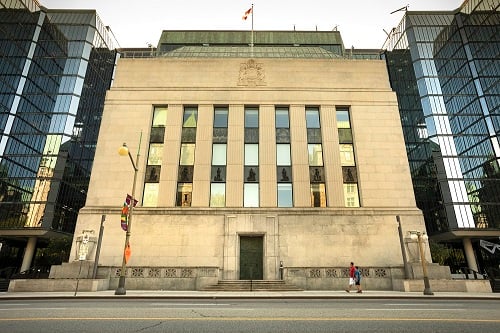Some observers note other factors besides coronavirus fueled the action

To the surprise of almost nobody, the Bank of Canada lowered its overnight rate by 50 basis points from 1.75% to 1.25%, one day after the US Federal Reserve took the surprise move of cutting its benchmark interest rate from by a half percentage point to a target range of 1.00% to 1.25%.
Canada’s previous 1.75% rate had been the highest among the G7 nations. But not unlike the US central bank, the BoC cited the increased economic risks posed by the coronavirus outbreak for the rate cut.
“While Canada’s economy has been operating close to potential with inflation on target, the COVID-19 virus is a material negative shock to the Canadian and global outlooks, and monetary and fiscal authorities are responding,” said the BoC in a press statement. “Before the outbreak, the global economy was showing signs of stabilizing, as the Bank had projected in its January Monetary Policy Report (MPR). However, COVID-19 represents a significant health threat to people in a growing number of countries. In consequence, business activity in some regions has fallen sharply and supply chains have been disrupted. This has pulled down commodity prices and the Canadian dollar has depreciated.”
The BoC announcement also noted that global markets were “reacting to the spread of the virus by repricing risk across a broad set of assets, making financial conditions less accommodative. It is likely that as the virus spreads, business and consumer confidence will deteriorate, further depressing activity.”
Among industry experts, reaction to the BoC move was mixed.
“This is the first time the Bank has lowered the rate since 2015 and not since the financial crisis has the bank dropped by 50 basis points in a single move,” said James Laird, co-founder of Ratehub.ca and president of CanWise Financial mortgage brokerage. “The evolving spread of the coronavirus has the Bank concerned about business investment, consumer confidence, and overall economic growth. Also, inflation in January was higher than expected.”
Laird noted that this will probably not be a one-shot action by the central bank.
“The Bank says they are ready to adjust monetary policy further,” he continued. “This suggests additional rate cuts may follow this year. Consumers who currently have a variable rate will see their mortgage payments drop once Canadian mortgage lenders adjust their prime rates, likely this week. The expectation is that prime rates will drop by the full 50 basis points, although there have been times when lenders have not passed along the full savings to their customers.”
Sherry Cooper, chief economist at Dominion Lending Centres, also welcomed the rate cut.
“Moving the full 50 basis points is a powerful message from the Bank of Canada,” she stated. “Particularly given that Governor Poloz has long been bucking the tide of monetary easing by more than 30 central banks around the world, concerned about adding fuel to a red hot housing market, especially in Toronto. Other central banks will no doubt follow, although already-negative interest rates hamper the euro-area and Japan.”
Cooper predicted the rate cut could “boost housing demand” via lower interest rates, although she admitted “reduced travel from China might crimp sales in Vancouver.” She also acknowledged that after the central bank made its announcement, “the 5-year Government of Canada bond yield plunged to a mere 0.82%, about half its level at the start of the year.”
There was also some skepticism over the rate cut. TD Economics director and senior economist Brian DePratto noted that while the BoC announcement heavily emphasized the risks related to the coronavirus outbreak, there were additional issues that helped to fuel its decision.
“Even ignoring the virus shock, domestic conditions were beginning to look less favourable,” he observed. “The Bank notes that first quarter growth will likely disappoint their prior 1.3% growth expectation, and that business investment has not met their expectations of recovery in the wake of positive trade policy developments. With no mention of household indebtedness or financial stability risks more broadly, this is clearly an organization focused on managing the near-term risks to economic growth.”
DePratto also suggested the coronavirus might be an overplayed excuse for this cut.
“The Bank sent an unequivocally dovish signal today, focused almost entirely on risks and with no mention of household indebtedness,” he continued. “Perhaps most telling is the statement that they ‘stand ready’ to adjust further should conditions warrant and are focused on ensuring liquidity remains ample. It is important to remember that monetary policy is only one part of the overall response toolkit, and arguably the least effective given its relatively blunt nature.”
Norman Levine, managing director of Portfolio Management Corporation, bluntly questioned the rate cut.
“A huge mistake by Stephen Poloz and the Bank of Canada,” he wrote on Twitter. “Should have been a 1/4 at most. Using up firepower that could have been used when really needed in the future. Interest rate cuts because of a virus and blockades. Really?”


